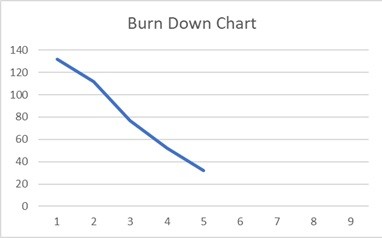PMI-ACP Practice Questions #113
You are managing a release cycle where each sprint duration is two weeks. The team has been making progress, as shown in the burndown chart.
As you approach Sprint 6, you need to consider the following factors:
- Sprint 6 has 3 holidays, reducing the available working days.
- One full team day is required for final release management activities (preparing for deployment, documentation, stakeholder alignment, etc.).
when can the release be made?

A. At the end of Sprint 6, since the current trend suggests the remaining work will be completed despite reduced working days.
B. We can’t predict the exact release date based on this data, as we need more information on teamcapacity.
C. At the end of Sprint 7, to provide extra buffer for potential last-minute fixes or unexpected delays.
D. Extend the release into Sprint 8 to ensure high quality and minimize any last-minute risks.
Analysis
The team is managing a release cycle with two-week sprints, and the burndown chart shows steady progress towards completion. As the team approaches Sprint 6, there are key factors to consider:
- Sprint 6 has three holidays, reducing available working days.
- One full team day is required for final release preparation, including deployment, documentation, and stakeholder alignment.
The burndown trend suggests that the remaining work should be completed by Sprint 7, given the team’s historical velocity of around 20–25 story points per sprint and the remaining work of approximately 30 story points. However, Sprint 6 has reduced capacity, making completion within that sprint uncertain.
A realistic and safe release plan should account for potential last-minute issues and ensure that work is completed without rushing or compromising quality.
Analysis of Options
A: At the end of Sprint 6 since the current trend suggests the remaining work will be completed despite reduced working days.
The team’s velocity has been steady, but Sprint 6 has fewer available working days due to holidays. While it is possible that the team could complete the work, predicting a Sprint 6 completion is risky due to reduced capacity. Given the available data, assuming completion within Sprint 6 is overly optimistic, making this option unreliable.
B: We can’t predict the exact release date based on this data, as we need more information on team capacity.
While it is true that exact dates are difficult to predict, the burndown trend and velocity data provide enough information to estimate when the work will be completed. The team has historical velocity data, and the trend suggests that Sprint 7 is a reasonable target. Saying that no prediction can be made is incorrect because the data available is sufficient to estimate the release window.
C: At the end of Sprint 7, to provide extra buffer for potential last-minute fixes or unexpected delays.
This is the best option because it accounts for both historical velocity trends and the reduced capacity in Sprint 6. The burndown trend suggests that work should be completed by Sprint 7, and planning the release at the end of Sprint 7 provides a safety buffer for any unforeseen issues. Since Agile teams prefer predictable, stable releases, this approach ensures a well-planned and risk-mitigated delivery.
D: Extend the release into Sprint 8 to ensure high quality and minimize any last-minute risks.
There is no clear indication that an extra sprint is required. The burndown chart suggests that the remaining work should be completed by mid-Sprint 7, meaning Sprint 8 is unnecessary. Extending the release without a valid reason would delay value delivery and contradict Agile principles of iterative and incremental releases.
Conclusion
The best answer is Option C: At the end of Sprint 7, to provide extra buffer for potential last-minute fixes or unexpected delays.
This option correctly considers:
- The historical velocity trend, which supports a Sprint 7 completion.
- The reduced working capacity in Sprint 6, making completion in that sprint uncertain.
- The need for buffer time for final release preparations, ensuring a smooth, high-quality launch.
This approach aligns with Agile best practices for managing release forecasts based on empirical data and risk mitigation strategies.
PMI – ACP Exam Content Outline Mapping
| Domain | Task |
| Delivery | Manage Agile Metrics |
Topics Covered:
- Sprint capacity planning and impact of reduced working days
- Release planning using historical velocity and burndown trends
- Managing Agile metrics for forecasting and delivery
- Risk mitigation through buffer inclusion in release timelines
- Aligning release readiness with quality and stakeholder coordination
If you’re preparing for the PMI Agile Certified Practitioner (PMI-ACP)® Exam, we highly recommend enrolling in our PMI-ACP® Exam Prep Program. Designed to provide a comprehensive Agile learning experience, this program not only helps you ace the PMI-ACP® exam but also enhances your Agile mindset, leadership skills, and ability to deliver value-driven projects. Ensure exam success and career growth with our expert-led, structured preparation program tailored for Agile professionals.